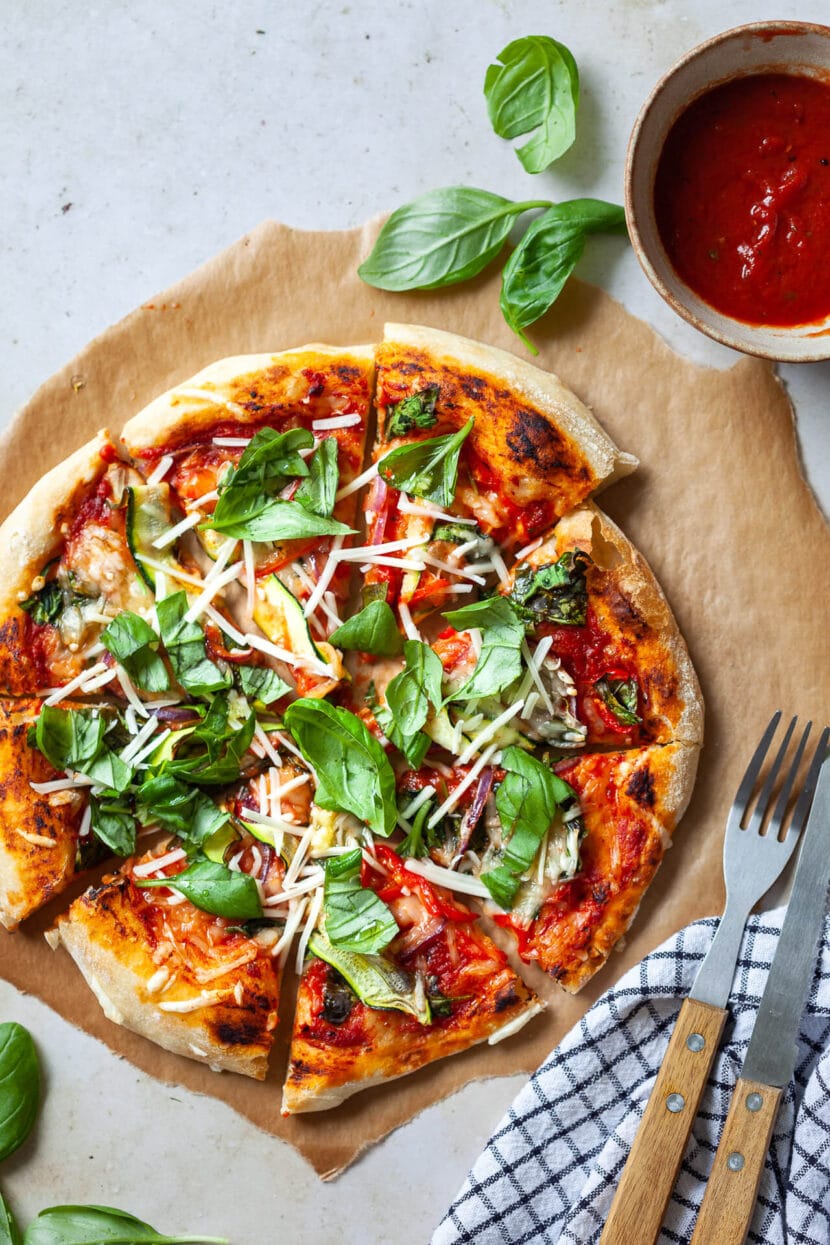An Easy Slow-Rise Overnight Pizza Recipe that comes together in minutes, tastes amazing, and is easy to digest! Simple & fully Vegan.
Did you know you can make a delicious Italian-style pizza right in your kitchen oven?
The secret lies in slow-rising the pizza dough, a good-quality strong flour, and a pizza stone. This is the only recipe we use now to make delicious Slow-Rise Overnight Pizza with big air-pockets and a crispy crust…. and all in our regular kitchen oven.
If you can’t go to Naples for pizza, let the Neapolitan pizza come to your house!
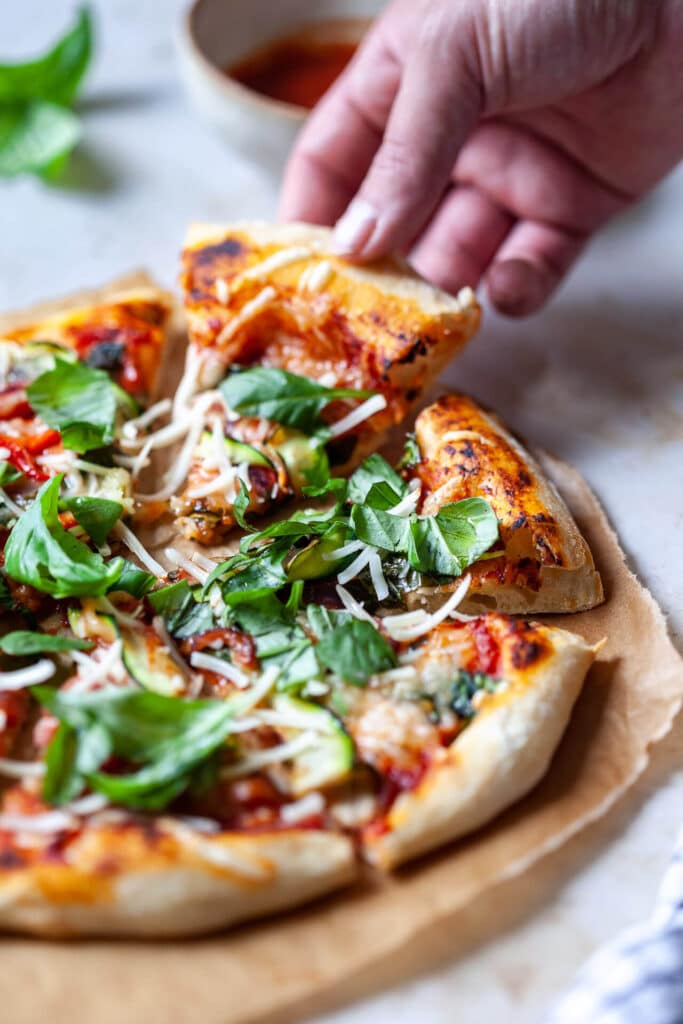
Pizza dough ingredients
To make an excellent pizza dough you’ll only need 5 basic ingredients, and time.
- luke-warm water
- dry yeast
- strong flour (we used manitoba flour, or type ’00’)
- salt
- olive oil
For this recipe, we use the measurements in metric as it is much more accurate to measure. In baking, measurements do matter.
Topping ingredients
Once your pizza dough is ready to use, you can top it however you like, be it a Margherita (tomato sauce, mozzarella, and basil) or make it vegan with these ingredients:
- passata, use a regular tomato passata (tomato sauce) or a ready-made pizza sauce if you like. Marinara would work as well.
- tomato puree. We like to combine passata (tomato sauce) with a bit of tomato puree to make it richer
- olive oil, add a drizzle of olive oil in the tomato sauce, or over the pizza. You can skip this to control the fat intake.
- oregano
- zucchini
- red pepper, or other vegetables, like mushroom, eggplant, tomato, corn,…
- baby spinach, fresh arugula would also work well
- vegan mozzarella, to make this recipe we used Violife grated mozzarella, but any other vegan mozzarella or pizza cheese should work. Choose a type that melts well and is creamy.
- fresh basil to top
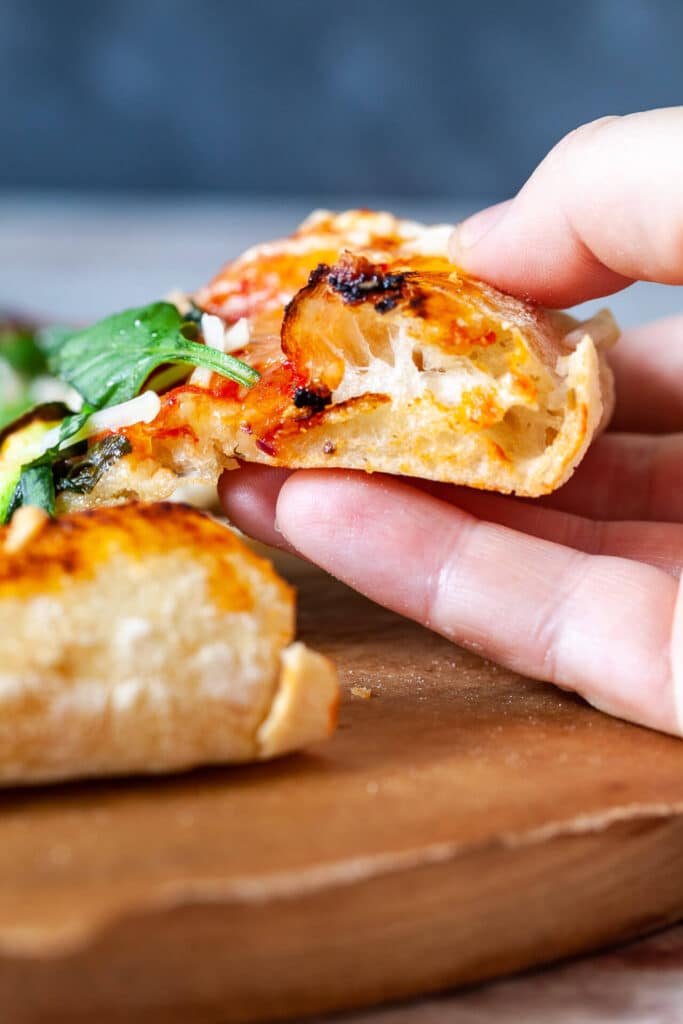
How to make this Easy Slow-Rise Overnight Pizza Dough
The pizza dough will make or break your final product, so it’s important to follow the procedure.
Start by combining water and dry yeast. Make sure your water is lukewarm. If needed, slightly warm the water beforehand. Once the water and yeast are stirred and combined, cover it and let sit for about 10 minutes. During this time the yeast will activate and become bubbly.
Important: If your yeast does not activate, trash it and start again! It may be old, or dead, and no amount of time will save it.
Next, add flour to a large bowl, and the salt to the side. Add water with yeast, and olive oil. Stir with a fork until the dough starts to stick, then drop the dough on your counter and proceed to knead by hand for a couple of minutes, until the dough is smooth and elastic. Don’t proof the dough, instead, return it to a lightly greased bowl, and cover tightly with cling foil. This will prevent the dough from drying out in the fridge.
Don’t let the dough proof on the counter, but place it in the fridge immediately and refrigerate overnight, ideally for anywhere between 18 to 36 hours.
Your dough will start rising in the fridge after a couple of hours, but will not overproof. When ready, it should be double in size and full of air pockets.
Shaping the pizza dough
Remove the dough from the fridge 2 hours before baking time. Turn the dough on a floured surface, gently shape it into a ball, and let rest covered for 2 hours. At this point you don’t want to lose the air bubbles, so don’t knead the dough, just gently shape it.
Divide the dough into equal pieces, two to four, depending on how large you want your pizza. We usually make 3 medium-sized pizzas.
Take a piece of dough, shape it roughly into a circle, and press your fingers about 1 cm / half an inch from the edge into the dough, making a raised edge. Next, from the center, stretch the dough out with your hands until the desired pizza size. I like to place the dough on top of my fist, and let gravity do the work, stretching it gently. Don’t knead your dough and don’t roll it out with a pin roller, or you’ll lose the air pockets.
Bake the pizza
Half an hour before baking time, heat your oven and pizza stone to 250°C / 480°F.
Prepare your tomato sauce and your toppings and have them ready on the counter.
Set a shaped pizza dough on a kitchen board covered with parchment paper and top it with tomato sauce, vegetables, and cheese.
Then, gently transfer the pizza with the parchment paper into the oven on the preheated pizza stone and bake until the dough is done, and the cheese is melted. Our baking time is about 8-10 minutes, but this will depend on the oven.
Once the pizza is baked, remove it from the oven, sprinkle with fresh basil and serve immediately. Repeat with the rest of the pizza dough.
Serving
Serve immediately while still hot from the oven, with a sprinkle of greens and basil. If your vegan cheese melted completely, add some more grated cheese on top.
Storage
Keep the dough refrigerated, or freeze it for up to 3 months. Once the pizza is baked, store it refrigerated for up to 2 days, and reheat before consuming.
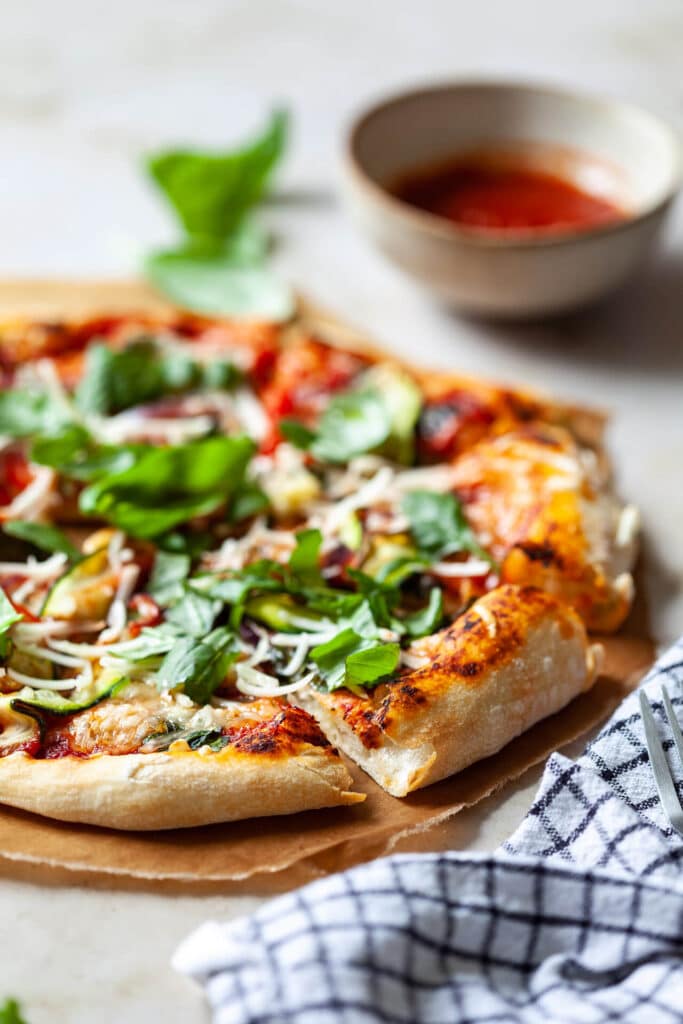
Why make a slow-rise dough?
Making a slow-rise dough could seem fastidious, but it’s no different than making the dough the usual way, … except for the proofing. With this method, you don’t proof the dough on the counter, instead, it goes straight into the fridge. The dough will still rise, but it will take longer, during which time the yeast will feed on the sugars in the flour and make the dough easier to digest.
The pizza will have a slightly tangier taste, as per the slow-rise fermentation, but it will be delicious, and easy on your digestion.
Why do I need a pizza stone?
A pizza stone is a smart trick to use when making pizza, or bread. A pizza stone (or baking stone) helps absorb moisture during baking, which in return helps to get a crispier dough texture. It also heats up evenly and is then very hot, so it helps mimic a traditional pizza oven, and allows for higher surface temperatures, ensuring a quick pizza bake.
The pizza stone must be heated along with your oven. This will make sure the stone heats up slowly and steadily, which prevents cracks or breaks from temperature shocks. Likewise, you should leave it to cool down in the oven, when you are done baking, and just give it a wipe once it’s cooled down.
If you have any other questions for us, leave us a comment, and we’ll try to get back to you asap.
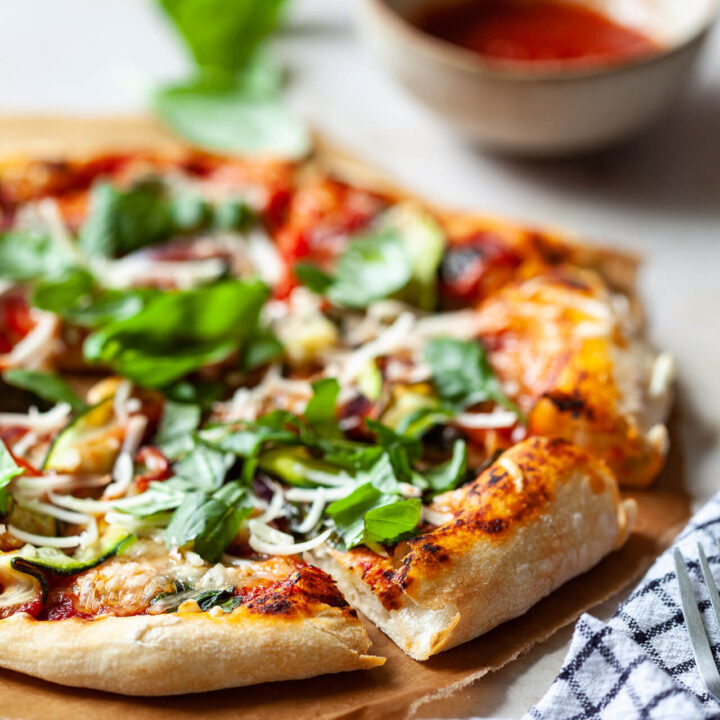
Easy Slow-Rise Overnight Pizza
An Easy Slow-Rise Overnight Pizza Recipe that comes together in minutes, tastes amazing, and is easy to digest! Simple & fully Vegan.
Ingredients
Pizza dough:
- 300 milliliters luke-warm water
- 6 grams dry yeast
- 400 grams strong flour (we used manitoba, or type '00')
- 3/4 tsp salt
- 1 tbsp olive oil
Toppings:
- 1 cup passata
- 1 tbsp tomato puree
- 1 tbsp olive oil
- pinch of oregano
- 1 zucchini
- 1 red pepper
- 2 cups baby spinach
- 2 cups vegan mozzarella (we used Violife grated mozzarella)
- 1/4 cup basil, fresh
Instructions
- Pour 300 milliliters of lukewarm water over 6 grams of dry yeast. Lightly warm the water beforehand, if needed, to bring it to a warm temperature. Stir the yeast with the water, cover the bowl with a lid, or napkin, and let sit 10 minutes for the yeast to activate. After 10 minutes the water should be bubbly, which means the yeast is ready.
- To a large bowl, add 400 grams of strong flour (type '00'), and 3/4 tsp salt on the side. Pour in the water and yeast mixture, and add 1 tbsp of olive oil. Stir with a fork until the dough starts to stick, then drop the dough on your counter and proceed to knead by hand for a couple of minutes, until the dough is smooth and elastic. No need to over-knead the dough.
- Very lightly grease your bowl, return the dough to the bowl and cover with cling foil tightly - make sure to make it air-tight, otherwise, your dough will dry in the fridge. Don't use a napkin for this! Place the covered bowl with the dough into the refrigerator for 18 hours (but you can go up to 36 hours).
- After the dough is rested, it should be double in size and full of air pockets.
- Remove the dough from the fridge 2 hours before baking time. Sprinkle your counter or working area with a generous amount of flour, then turn the dough gently out of the bowl and onto the counter. Don't knead the dough, just gently shape it into a ball, otherwise, you will lose the air pockets! Cover the dough with a bowl (turn it upside down over the dough) and let it rest on the counter for 2 hours.
- Half an hour before baking time, heat your oven and pizza stone to 250°C / 480°F. If you have a pizza program on your oven, use that.
- Prepare your toppings: mix 1 cup passata with 1 tbsp tomato puree, 1 tbsp olive oil, and a pinch of oregano. Slice your zucchini and red pepper. Wash and dry the baby spinach and basil. Grate or tear your mozzarella.
- Divide the dough into 4 equal pieces (if you want large pizzas, just make 2 or 3 pieces).
- Take a piece of dough, set it on the counter before you. Then, shape it roughly into a circle, and press your fingers about 1 cm / half an inch from the edge into the dough, making a raised edge. Don't knead your dough and don't roll it out with a pin roller, or you'll lose the air pockets. Next, from the center, stretch the dough out until the desired pizza size. I like to place the dough on top of my fist, and let gravity do the work, stretching it gently.
- Once your pizza dough is ready, set it on a kitchen board covered with parchment paper - this will help transfer the pizza. Top your pizza with tomato sauce, vegetables, and cheese. Then, gently transfer the pizza on parchment paper into the oven (leave the kitchen board out of the oven!) on the preheated pizza stone and bake until the dough is done, and the cheese is melted; approximately 8-10 minutes (depending on the oven).
- Once the pizza is baked, remove it from the oven, sprinkle with fresh basil and serve immediately.
- Repeat with the rest of the pizza dough.
Notes
We like to use Manitoba flour or type 00 flour for this recipe, as it has a larger amount of protein, which helps create strong gluten bonds. In a pinch, other types of flour will work, but let it ferment just a couple of hours, or overnight (8 hours max).
Nutrition Information:
Yield: 4 Serving Size: 1Amount Per Serving: Calories: 449Total Fat: 8gSaturated Fat: 1gTrans Fat: 0gUnsaturated Fat: 6gCholesterol: 0mgSodium: 456mgCarbohydrates: 81gFiber: 4gSugar: 3gProtein: 12g
Nutrition data is automatically calculated using Nutritionix and may not be accurate.
If you like this recipe, you can let us know in the comments below or on social media using #vibrantplate and tag us @vibrantplate. We’re always happy to read your feedback and LOVE seeing your take on our recipes.
Ger more breads recipes over here!
You can connect with us on our Instagram, Facebook, or Pinterest. We share many behind-the-scenes photos and step-by-step recipes in our Instagram Stories, so be sure to check it out!

